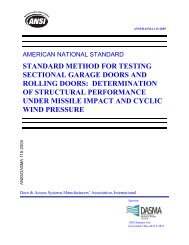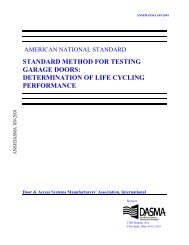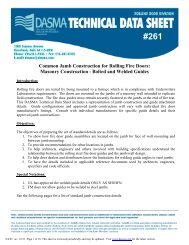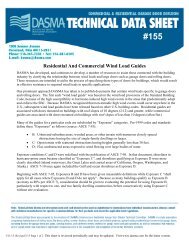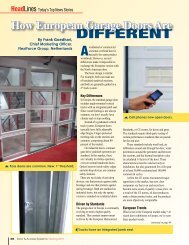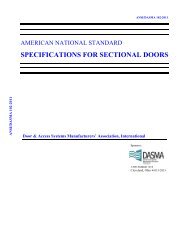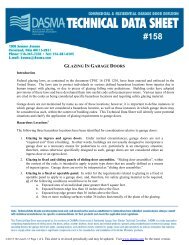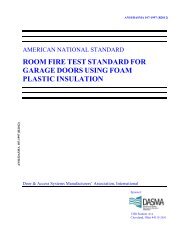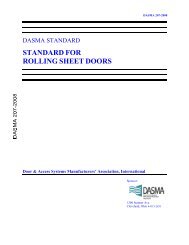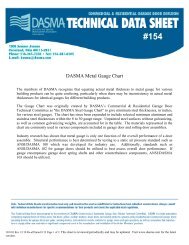Rolling Steel Fire Doors and Balanced Fire Protection - Dasma.com
Rolling Steel Fire Doors and Balanced Fire Protection - Dasma.com
Rolling Steel Fire Doors and Balanced Fire Protection - Dasma.com
- No tags were found...
Create successful ePaper yourself
Turn your PDF publications into a flip-book with our unique Google optimized e-Paper software.
#278<strong>Rolling</strong> <strong>Steel</strong> <strong>Fire</strong> <strong>Doors</strong> <strong>and</strong> <strong>Balanced</strong> <strong>Fire</strong> <strong>Protection</strong>IntroductionDASMA supports the principle of “balanced fire protection”, historically referred to as containment,<strong>com</strong>partmentalization <strong>and</strong> suppression, in building construction. In recent times there has been a shifttoward suppression as the primary means of fire protection. This is best reflected in the publishing ofthe initial version of the International Building Code in 2000. A number of provisions favoringsuppression, known for many years as “sprinkler trade-offs”, were incorporated into the IBC. Some ofthese “trade-offs” involved the reduction or elimination of rated walls in lieu of automatic firesuppression systems such as automatic sprinklers.DASMA has received inquiries from various parties regarding the use of automatic fire suppressionsystems, including sprinkler systems designed to form “water curtains”, in lieu of fire-rated rolling steeldoors. The following questions <strong>and</strong> answers will help clarify issues relating to such “trade-offs”.What is “balanced fire protection”?<strong>Balanced</strong> fire protection is where a building is designed with a balance of “active” protection systems(e.g. automatic sprinklers) <strong>and</strong> “passive” protection systems (e.g. fire-rated walls) to maximize propertyprotection, minimize personal injury/death <strong>and</strong> facilitate emergency responders.What role do rolling steel fire doors play in fire resistance?<strong>Rolling</strong> steel fire doors are <strong>com</strong>monly used in buildings where interior firewalls have been constructedto separate areas within building to contain potential fires within the building spaces. Such doors canalso be used in exterior applications to protect against fire risk from adjacent buildings. Wallconstruction within buildings requiring fire rated walls could be specified to be carry a 4, 3, 1 ½ or ¾hour fire ratings. Typically, openings in firewalls are protected by fire rated rolling steel doors.2/14/13; Revised 10/09; Reaffirmed 1/2013. Page 1 of 2 This sheet is reviewed periodically <strong>and</strong> may be updated. Visit www.dasma.<strong>com</strong> for thelatest version.
#278When the three major model building codes were consolidated into the IBC, were there any provisionschanged affecting fire-rated rolling steel doors?Yes. Two sets of provisions within the IBC allow for eliminating the use of such doors. One provision allows forelimination of ¾ hour rolling steel doors when a building is equipped with an automatic fire suppression system.The other provision allows for the elimination of a fire rating for any exterior rolling steel door if a “watercurtain” is installed. These provisions are <strong>com</strong>monly known as “sprinkler trade-offs.”What is a “sprinkler trade-off”?Generally, the term “sprinkler trade-off” means that fire-resistance requirements for certain building materials arereduced or eliminated when various automatic fire suppression systems, e.g. sprinklers, are incorporated into abuilding’s design.If an automatic fire suppression system is present, why should rolling steel fire doors be considered?The use of rolling steel fire doors in conjunction with an automatic fire suppression system offers a superior levelof safety to protect life <strong>and</strong> property. Such doors are designed to automatically close to help contain fireconditions, while automatic sprinklers help extinguish fire conditions. Further, any concerns about the reliabilityof automatic fire suppression systems (e.g. frozen piping, unavailability of outside water service, disconnection ofservice, system malfunction) can be balanced by the inclusion of rolling steel fire doors.What can happen if a large opening is covered by a non-fire rated rolling steel door?A large opening covered by a rolling steel door that is not fire rated will not automatically close under fireconditions, allowing an opportunity for fire <strong>and</strong> burning objects to pass through from one side of the opening tothe other <strong>and</strong> thus setting up the possibility for <strong>com</strong>promising life <strong>and</strong> property.What if a “water curtain” ends up being specified instead of a rolling steel fire door?If a “water curtain” is specified to protect a rolling steel door in lieu of a fire-rated door, it should bedesigned for use with the specific rolling steel door installed. For the “water curtain”, keep in mind thatthe IBC requires <strong>com</strong>pliance with NFPA 13, an automatic water supply <strong>and</strong> a fire departmentconnection. Projectiles through a wall opening are not contained by a water curtain, but can besuccessfully contained by a rolling steel fire door.What additional features can rolling steel fire doors provide besides fire resistance?In addition to fire resistance <strong>and</strong> prevention of the passage of projectiles, rolling steel fire doors can also be ratedas smoke door assemblies. The rolling steel fire door industry can supply doors tested in accordance with UL1784.2/14/13; Revised 10/09; Reaffirmed 1/2013. Page 2 of 2 This sheet is reviewed periodically <strong>and</strong> may be updated. Visit www.dasma.<strong>com</strong> for thelatest version.



